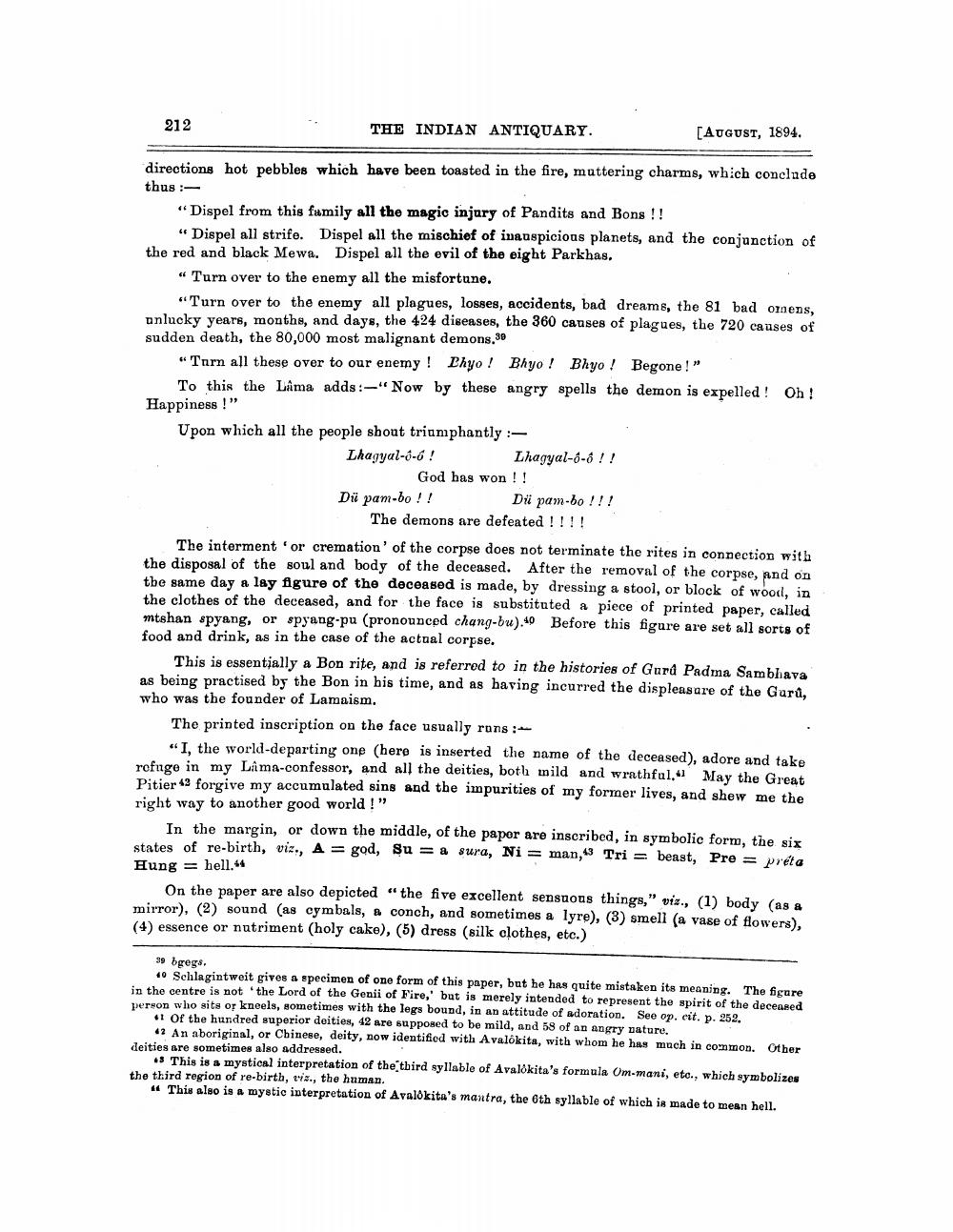________________
212
THE INDIAN ANTIQUARY.
[AUGUST, 1894.
directions hot pebbles which have been toasted in the fire, muttering charms, which conclude thus :
"Dispel from this family all the magic injury of Pandits and Bons !!
“Dispel all strife. Dispel all the mischief of inauspicious planets, and the conjunction of the red and black Mewa. Dispel all the evil of the eight Parkhas.
“ Turn over to the enemy all the misfortune.
"Turn over to the enemy all plagues, losses, accidents, bad dreams, the 81 bad omens, unlucky years, months, and days, the 424 diseases, the 360 causes of plagues, the 720 causes of sudden death, the 80,000 most malignant demons.30
"Turn all these over to our enemy ! Lhyo! Bhyo ! Bhyo ! Begone!"
To this the Lima adds:-"Now by these angry spells the demon is expelled! Oh! Happiness !" Upon which all the people shoat triumphantly :Lhagyal-6-6 !
Lhagyal-8-8 !! God has won !! Dü pam-bo!!
Di pam-bo !!!
The demons are defeated !!!! The interment or cremation of the corpse does not terminate the rites in connection with the disposal of the soul and body of the deceased. After the removal of the corpse, and on the same day a lay figure of the deceased is made, by dressing a stool, or block of wood, in the clothes of the deceased, and for the face is substituted a piece of printed paper, called mtehan spyang, or spyang-pu (pronounced chang-bu).40 Before this figure are set all sorts of food and drink, as in the case of the actual corpse.
This is essentially a Bon rite, and is referred to in the histories of Gurd Padma Sambhava as being practised by the Bon in his time, and as having incurred the displeasure of the Guru, who was the founder of Lamaism.
The printed inscription on the face usually runs :
“I, the world-departing one (here is inserted the name of the deceased), adore and take rofuge in my Lama-confessor, and all the deities, both mild and wrathful. May the Great Pitier 12 forgive my accumulated sins and the impurities of my former lives, and shew me the right way to another good world !"
In the margin, or down the middle, of the paper are inscribed, in symbolic form, the six states of re-birth, viz., A= god, Su = a sura, Ni = man,3 Tri = beast, Pre = preta Hung = hell.44
On the paper are also depicted "the five excellent sensuous things," viz., (1) body (as a mirror), (2) sound (as cymbals, a conch, and sometimes a lyre), (3) smell (a vase of flowers), (4) essence or nutriment (holy cake), (5) dress (silk clothes, etc.)
39 bgegs.
40 Schlagintweit gives a specimen of one form of this paper, but he has quite mistaken its meaning. The figure in the centre is not the Lord of the Genii of Fire,' but is merely intended to represent the spirit of the deceased person who site or kneels, sometimes with the legs bound, in an attitude of adoration. See op. cit. p. 252.
1 of the hundred superior deities, 42 are supposed to be mild, and 59 of an angry nature.
42 An aboriginal, or Chinese, deity, now identified with Avalokita, with whom he has much in common. Other deities are sometimes also addressed.
This is a mystical interpretation of the third syllable of Avalokita's formula Om-mani, etc., which symbolizes the third region of re-birth, tis., the human.
4 This also is a mystic interpretation of Avalokita's mantra, the 6th syllable of which is made to mean hell.




